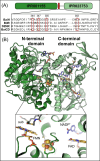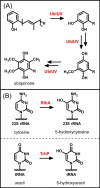Iron-sulfur cluster-dependent enzymes and molybdenum-dependent reductases in the anaerobic metabolism of human gut microbes
- PMID: 39504489
- PMCID: PMC11574389
- DOI: 10.1093/mtomcs/mfae049
Iron-sulfur cluster-dependent enzymes and molybdenum-dependent reductases in the anaerobic metabolism of human gut microbes
Abstract
Metalloenzymes play central roles in the anaerobic metabolism of human gut microbes. They facilitate redox and radical-based chemistry that enables microbial degradation and modification of various endogenous, dietary, and xenobiotic nutrients in the anoxic gut environment. In this review, we highlight major families of iron-sulfur (Fe-S) cluster-dependent enzymes and molybdenum cofactor-containing enzymes used by human gut microbes. We describe the metabolic functions of 2-hydroxyacyl-CoA dehydratases, glycyl radical enzyme activating enzymes, Fe-S cluster-dependent flavoenzymes, U32 oxidases, and molybdenum-dependent reductases and catechol dehydroxylases in the human gut microbiota. We demonstrate the widespread distribution and prevalence of these metalloenzyme families across 5000 human gut microbial genomes. Lastly, we discuss opportunities for metalloenzyme discovery in the human gut microbiota to reveal new chemistry and biology in this important community.
Keywords: anaerobic metabolism; human gut microbiota; iron-sulfur cluster; metalloenzyme; molybdenum cofactor; redox chemistry.
© The Author(s) 2024. Published by Oxford University Press.
Figures








Similar articles
-
A widely distributed metalloenzyme class enables gut microbial metabolism of host- and diet-derived catechols.Elife. 2020 Feb 18;9:e50845. doi: 10.7554/eLife.50845. Elife. 2020. PMID: 32067637 Free PMC article.
-
Molybdenum-cofactor-containing enzymes: structure and mechanism.Annu Rev Biochem. 1997;66:233-67. doi: 10.1146/annurev.biochem.66.1.233. Annu Rev Biochem. 1997. PMID: 9242907 Review.
-
The role of FeS clusters for molybdenum cofactor biosynthesis and molybdoenzymes in bacteria.Biochim Biophys Acta. 2015 Jun;1853(6):1335-49. doi: 10.1016/j.bbamcr.2014.09.021. Epub 2014 Sep 28. Biochim Biophys Acta. 2015. PMID: 25268953 Free PMC article. Review.
-
Anaerobic 4-hydroxyproline utilization: Discovery of a new glycyl radical enzyme in the human gut microbiome uncovers a widespread microbial metabolic activity.Gut Microbes. 2018;9(5):437-451. doi: 10.1080/19490976.2018.1435244. Epub 2018 Jun 4. Gut Microbes. 2018. PMID: 29405826 Free PMC article.
-
Redox centers of 4-hydroxybenzoyl-CoA reductase, a member of the xanthine oxidase family of molybdenum-containing enzymes.J Biol Chem. 2001 Dec 21;276(51):47853-62. doi: 10.1074/jbc.M106766200. Epub 2001 Oct 15. J Biol Chem. 2001. PMID: 11602591
Cited by
-
NRVS of FeS cluster proteins & models - A bestiary of nifty normal modes.J Inorg Biochem. 2025 Sep;270:112935. doi: 10.1016/j.jinorgbio.2025.112935. Epub 2025 Apr 27. J Inorg Biochem. 2025. PMID: 40424687 Review.
-
Commensal resilience: ancient ecological lessons for the modern microbiota.Infect Immun. 2025 Jun 10;93(6):e0050224. doi: 10.1128/iai.00502-24. Epub 2025 May 19. Infect Immun. 2025. PMID: 40387449 Free PMC article. Review.
References
Publication types
MeSH terms
Substances
Grants and funding
LinkOut - more resources
Full Text Sources
Miscellaneous

